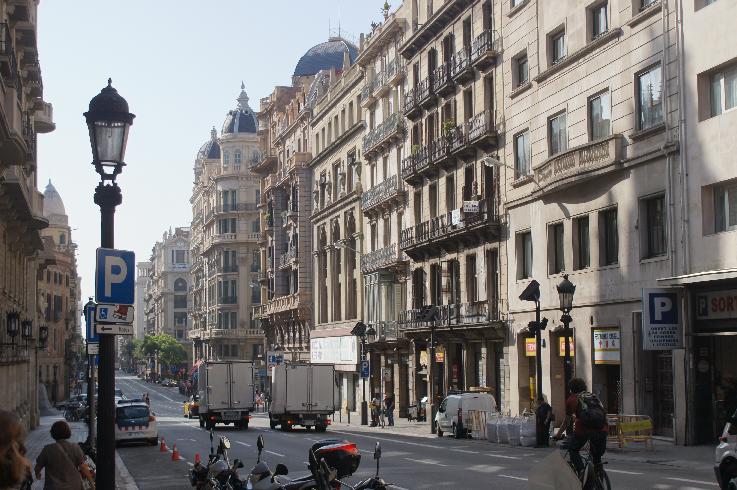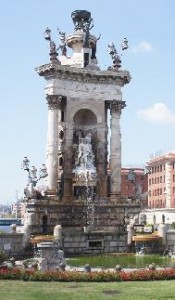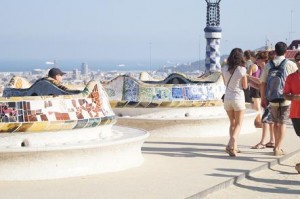It’s probably not fair comparing the public art and architecture of Virginia cities, none of which are much more than 200 years old, with Barcelona, whose history stretches back 2,000 years. But I’m going to do it anyway. But before I start, let me be clear about one thing: I am not suggesting that Richmond, Norfolk or Charlottesville should try to be like Barcelona. They never can be, and it is futile to try. We can never make up an 1,800-year history deficit. But perhaps we can learn from and be inspired by the example of other cities and regions.
One of the first things that strikes visitors to Barcelona is the prevalence of art. Indeed, one could say that the city itself is a work of art. As can be seen in the photograph at the top of the post, builders of nearly every building have paid incredible attention to the details, be they the stone facades, the iron grill work or the architectural adornments. Even the city’s newer buildings, which incorporate elements such as tile roofs and colorful awnings, are visually arresting. Add to it the acknowledged architectural masterpieces like Antonio Gaudi’s cathedral, still under construction, and the result is a city where visitors (and, no doubt, residents) find themselves delighted at every turn.
Barcelonians have created an urban fabric worth preserving. Even when developers gut the interior of buildings, they often retain the masterfully decorated facades. Yet the city does not slavishly hew to the past. Barcelonians have encouraged architectural and artistic innovation. Thus buildings of startling different looks (though not size and scale) often stand side by side. Somehow, builders (or planners) are discriminating enough to know what works and what doesn’t.
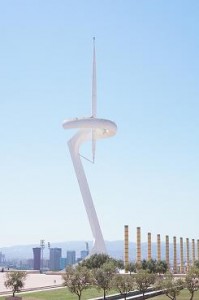
Every city has telecommunications towers. Not every city turns its towers into works of art. This tower is located near Barcelona's 1992 Olympic complex.
How can Virginia compete with an architectural legacy accumulated over 2,000 years? It won’t be easy. But only the tiny Gothic district of Barcelona goes back a full 2,000 years; the modern city dates back only to the mid-19th century. Even Richmond has 150-year-old neighborhoods. The difference is that Barcelona stuck with a winning model while Virginians abandoned traditional urban development after World War II in favor of building the scattered, disconnected, low-density places that we call the “suburbs.” For the past half century, we have poured our resources into throw-away communities that, offering little more than their newness, depreciated rapidly. As a result, across innumerable communities, many buildings have so little intrinsic value that it makes more sense to tear them down and rebuild from scratch than to renovate them.
Now, consider the difference between those two approaches from the perspective of long-term wealth accumulation. Take a suburban Virginia mall built in 1960. After 50 years, the buildings and structures have zero value and must be replaced. That represents an average depreciation of 2% annually. (Forgive me for not calculating an annually compounded rate of depreciation; I’m using rough numbers.) Then take a mixed-use apartment/commercial building built in Barcelona. After five decades, the building needs a major rehab but the basic structure and facade are preserved intact. Let’s say, for purposes of argument, that the building experiences an average depreciation of only 1% annually. The Barcelona model preserves economic value. The Virginia model squanders economic value. Extrapolate the difference over an entire region. After a half century, the Barcelona model preserves billions of dollars more in economic value than the Virginia model. That measure of wealth creation and preservation is not reflected in traditional economic indices of such as Gross Domestic Product but it is no less real. Barcelona has built a storehouse of real estate value that leaves Virginia eating red-clay dust.
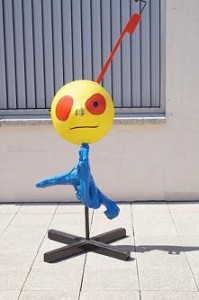
It helps to have world famous artists like surrealist Joan Miro. This whimsical piece appears outside Barcelona's Miro museum.
An argument also can be advanced that Virginians under-invest in public art and monuments. When I say “public” art, I don’t mean “public sector” art, although I don’t exclude it. I refer to art placed in public spaces for public enjoyment. Also, I don’t necessarily mean monuments of dead white men on horses like that on Richmond’s Monument Ave., as much as I happen to think that Robert E. Lee and Stonewall Jackson represent a heritage worth remembering. (I admire their personal honor and military valor, not their defense of a slave-holding state, so please don’t rag me about that.) Rather, when I talk about public art, I refer to the full range of art, from heroes on pedestals to abstract statuary, from ornamental stone carving to urban painting on brick walls.
In Barcelona, you can find art and statuary everywhere. Some of it honors figures from Catalonian history that mean absolutely nothing to Americans, but some of it is whimsical and delightful. Sometimes it is displayed in public squares, like Gaudi’s colorful benches at Parc Guell. Sometimes, it is tucked away in urban nooks and crannies like the anonymous painting on a garage door show below. Art is omnipresent — you can’t get away from it. And that is part of Barcelona’s charm.
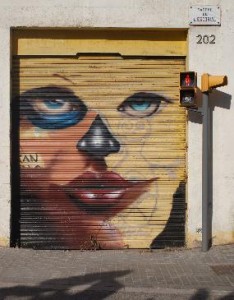
Some of the most delightful art is anonymous and transient, such as this painting found on the corrugated metal door of a parking garage.
No doubt I have confused many readers with my previous panegyrics to public art in Richmond. Certainly, there is no way to measure the economic benefit of such initiatives. Yet art is a critical part of “place making”: creating the kinds of public spaces where people enjoy spending time and interacting. And making great places is a critical part of building a vibrant, dynamic community where creative, skilled and educated people like to live. If my recent discourses on Barcelona have shown anything, it is that the building of prosperous, livable and sustainable regions will require Virginians to pull together many strands of thinking — and public art is one that cannot be neglected.

